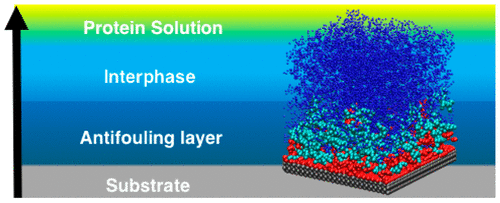当前位置:
X-MOL 学术
›
Macromolecules
›
论文详情
Our official English website, www.x-mol.net, welcomes your feedback! (Note: you will need to create a separate account there.)
Generalized Protein-Repellent Properties of Ultrathin Homopolymer Films
Macromolecules ( IF 5.5 ) Pub Date : 2020-06-26 , DOI: 10.1021/acs.macromol.0c01010 Daniel Salatto 1 , Yuto T. Koga 2 , Yashasvi Bajaj 1 , Zhixing Huang 1 , Benjamin M. Yavitt 1 , Yizhi Meng 1 , Jan-Michael Y. Carrillo 3 , Bobby G. Sumpter 3 , Dmytro Nykypanchuk 4 , Takashi Taniguchi 5 , Maya K. Endoh 1 , Tadanori Koga 1, 6
Macromolecules ( IF 5.5 ) Pub Date : 2020-06-26 , DOI: 10.1021/acs.macromol.0c01010 Daniel Salatto 1 , Yuto T. Koga 2 , Yashasvi Bajaj 1 , Zhixing Huang 1 , Benjamin M. Yavitt 1 , Yizhi Meng 1 , Jan-Michael Y. Carrillo 3 , Bobby G. Sumpter 3 , Dmytro Nykypanchuk 4 , Takashi Taniguchi 5 , Maya K. Endoh 1 , Tadanori Koga 1, 6
Affiliation

|
Fouling is the undesirable accumulation of a material on a wide variety of objects and has now become a widespread global problem from land to ocean with both economic and environmental penalties. Here, we report protein-repellent properties of ultrathin polymer films that are considered to be of structural origin and generalizable across homopolymer systems. Ultrathin polymer films composed of polystyrene, poly(2-vinyl pyridine), poly(methyl methacrylate), and polybutadiene with different thicknesses (h) ranging from 2 to 60 nm were prepared on silicon substrates. Bovine serum albumin and fibrinogen (both are fluorescein-labeled) were used as model proteins. The polymer thin films were incubated in the protein solution, removed, and then rinsed with water. The fluorescence intensity I(h) measured by a photon-counting spectrofluorometer generated a master curve over the film thickness regardless of the polymer and protein choice, revealing the two different protein adsorption regimes with the following thicknesses: (i) below the critical thickness (hc ≅ 20 nm), I(h) is minimal (nearly zero at h < 5 nm) and exhibits a very weak thickness dependence; (ii) at h > hc, I(h) exhibits very strong thickness dependence (I(h) ∼ h2). Molecular dynamics simulations identified a positive correlation between protein adsorption and highly packed conformations of polymer chains, which either adsorb on the substrate or do not adsorb but are in contact with the adsorbed polymer chains, resulting in a protein-repellent “dense layer” at h < hc. In addition, the effect of the dense layer propagates into the film interior up to at least 60 nm, resulting in an “interphase” that shows the quadratic adsorption behavior. These experimental and computational findings detail a new mechanism behind the structure-driven protein-repellent properties of polymer structures under nanoconfinement over surface chemistry.
中文翻译:

超薄均聚物薄膜的广义蛋白排斥特性
结垢是材料在各种物体上的不希望有的积累,并且现在已经成为从陆地到海洋的广泛的全球性问题,同时受到经济和环境方面的惩罚。在这里,我们报告了超薄聚合物薄膜的蛋白质排斥特性,该薄膜被认为是结构起源并且可在整个均聚物体系中推广。在硅基板上制备了由不同厚度(h)在2至60 nm之间的聚苯乙烯,聚(2-乙烯基吡啶),聚(甲基丙烯酸甲酯)和聚丁二烯组成的超薄聚合物薄膜。牛血清白蛋白和纤维蛋白原(均用荧光素标记)用作模型蛋白。将聚合物薄膜在蛋白质溶液中孵育,除去,然后用水冲洗。荧光强度I(ħ通过光子计数光谱荧光测量)产生过度的膜厚的主曲线不管聚合物和蛋白质的选择,揭示具有以下厚度的两个不同的蛋白质吸附机制:(i)所述临界厚度(下面ħ Ç ≅20 nm),I(h)最小(在h <5 nm时几乎为零),并且厚度依赖性很弱;(ii)在h > h c时,I(h)表现出非常强的厚度依赖性(I(h)〜h 2)。分子动力学模拟确定了蛋白质吸附与聚合物链的高度堆积构型之间的正相关关系,聚合物链要么吸附在基质上,要么不吸附,但与吸附的聚合物链接触,从而在h < h c。此外,致密层的影响传播到薄膜内部,直至至少60 nm,导致“界面相”表现出二次吸附行为。这些实验和计算结果详细说明了纳米约束下表面化学作用下聚合物结构的结构驱动的蛋白排斥特性背后的新机制。
更新日期:2020-08-11
中文翻译:

超薄均聚物薄膜的广义蛋白排斥特性
结垢是材料在各种物体上的不希望有的积累,并且现在已经成为从陆地到海洋的广泛的全球性问题,同时受到经济和环境方面的惩罚。在这里,我们报告了超薄聚合物薄膜的蛋白质排斥特性,该薄膜被认为是结构起源并且可在整个均聚物体系中推广。在硅基板上制备了由不同厚度(h)在2至60 nm之间的聚苯乙烯,聚(2-乙烯基吡啶),聚(甲基丙烯酸甲酯)和聚丁二烯组成的超薄聚合物薄膜。牛血清白蛋白和纤维蛋白原(均用荧光素标记)用作模型蛋白。将聚合物薄膜在蛋白质溶液中孵育,除去,然后用水冲洗。荧光强度I(ħ通过光子计数光谱荧光测量)产生过度的膜厚的主曲线不管聚合物和蛋白质的选择,揭示具有以下厚度的两个不同的蛋白质吸附机制:(i)所述临界厚度(下面ħ Ç ≅20 nm),I(h)最小(在h <5 nm时几乎为零),并且厚度依赖性很弱;(ii)在h > h c时,I(h)表现出非常强的厚度依赖性(I(h)〜h 2)。分子动力学模拟确定了蛋白质吸附与聚合物链的高度堆积构型之间的正相关关系,聚合物链要么吸附在基质上,要么不吸附,但与吸附的聚合物链接触,从而在h < h c。此外,致密层的影响传播到薄膜内部,直至至少60 nm,导致“界面相”表现出二次吸附行为。这些实验和计算结果详细说明了纳米约束下表面化学作用下聚合物结构的结构驱动的蛋白排斥特性背后的新机制。


























 京公网安备 11010802027423号
京公网安备 11010802027423号